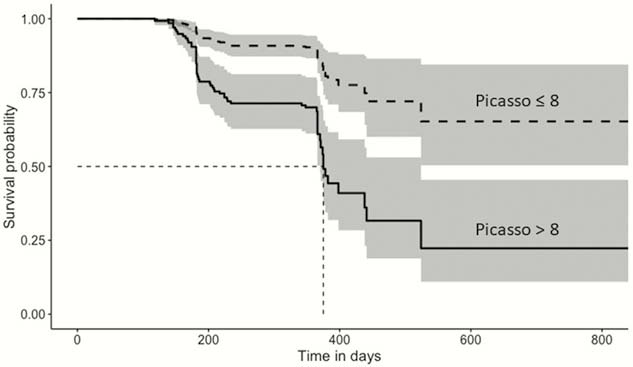OP26 The first real-life multicentre prospective validation study of the electronic chromoendoscopy score (Paddington International Virtual ChromoendoScopy ScOre) and its outcome in ulcerative colitis
M. Iacucci1, S.C. Smith2, A. Bazarova2, U.N. Shivaji1, P. Bhandari3, R. Cannatelli2, M. Daperno4, J.G. Ferraz5, M. Goetz6, X. Gui7, B. Hayee8, G. De Hertogh9, M. Lazarev10, J. Li11, O.M. Nardone2, V. Occhipinti12, R. Panaccione5, A. Parra-Blanco13, L. Pastorelli12, T. Rath14, G. Tontini15, M. Vieth16, V. Villanacci17, D. Zardo18, R. Kiesslich19, R. Bisschops20, S. Ghosh1
1Department of Gastroenterology, NIHR Birmingham Biomedical Research Centre, Birmingham, UK, 2Department of Gastroenterology, Institute of Translational Medicine, University of Birmingham, Birmingham, UK, 3Department of Gastroenterology, Queen Alexandra Hospital, Portsmouth, UK, 4Department of Gastroenterology, University of Torino, Torino, Italy, 5Department of Gastroenterology, University of Calgary, Calgary, Canada, 6Department of Gastroenterology, Klinikum Boblingen, Boblingen, Germany, 7Department of Pathology, University of Washington, Seattle, USA, 8Department of Gastroenterology, Kings College London, London, UK, 9Department of Pathology, University Hospitals Leuven, Leuven, Belgium, 10Department of Gastroenterology, Johns Hopkins University, Baltimore, USA, 11Department of Gastroenterology, Peking Union Medical College Hospital, Beijing, China, 12Department of Gastroenterology, IRCCS Policlinico San Donato, Milan, Italy, 13Department of Gastroenterology, University of Nottingham, Nottingham, UK, 14Department of Gastroenterology, University of Erlangen, Erlangen, Germany, 15Department of Pathophysiology and Transplantation, University of Milan, Milan, Italy, 16Department of Pathology, Kinikum Bayreuth, Bayreuth, Germany, 17Department of Pathology, Institute of Pathology Spedali Civili Brescia, Brescia, Italy, 18Department of Pathology, University Hospital Birmingham NHS Trust, Birmingham, UK, 19Department of Gastroenterology, Helios HSK Wiesbaden, Wiesbaden, Germany, 20Department of Gastroenterology, University Hospitals Leuven, Leuven, Belgium
Background
Mucosal healing is an important goal in the treatment of ulcerative colitis (UC). The newly published PICaSSO score characterises subtle mucosal and vascular changes and defines mucosal healing. We aimed to validate in real-life the PICaSSO score and assess its ability to predict relapse.
Methods
Patients with UC were prospectively recruited from 11 international centres. Participating endoscopists experienced in IBD received training on PICaSSO before starting the study. The rectum and sigmoid were examined using iScan 1,2 and 3 (Pentax, Japan) and inflammatory activity was assessed using UCEIS and PICaSSO. Biopsies were taken for the histological assessment using Robarts Histological Index (RHI) and Nancy. Follow-up was obtained at 12 months.
Results
A total of 278 patients were recruited (Table 1). The diagnostic performance in predicting histologic healing is shown in Table 2. When using PICaSSO score of ≤3 for mucosal and vascular architecture the AUROC to predict healing by RHI is 0.79 (95% CI 0.74–0.85) and 0.73 (95% CI 0.68–0.80) respectively and when using the Nancy score the AUROC is 0.78 (95% CI 0.72–0.84) and 0.77 (0.71–0.84). A total PICaSSO score of ≤8 and UCEIS score of ≤1 predicts remission at 12 months with an AUROC of 0.73 (0.65–0.80) and 0.71 (0.64–0.79). A Kaplan–Meier curve shows a favourable survival probability without relapse with a PICASSO score of ≤8 (Figure 1).
| Characteristics | Patients ( |
| Age (years) mean ± SD | 48.3 ± 14.7 |
| Extension of disease, | |
| Left-sided colitis | 121(43.5%) |
| Sub-total or total colitis | 155(55.8%) |
| Unknown | 2(0.7%) |
| Disease duration (y) mean ± SD | 14.0 ± 10.6 |
| Total Mayo clinical score, mean ± SD | 2.2 ± 2.8 |
| Therapy, | |
| No treatment | 24(8.6%) |
| NSAID | 15(5.4%) |
| 5-ASA | 204(73.4%) |
| Steroids | 17(6.1%) |
| Immunomodulators | 71(25.5%) |
| Biologics | 98(35.3%) |
| Score | RHI(≤3) (95% CI) | Nancy (≤1) (95% CI) |
| PiCASSO Total (≤8) | ||
| a | 94.6%(71.9–97.6) | 78.8%(37.4–86.6) |
| b | 57.7%(32.7–66.9) | 64.8%(28.5–73.6) |
| c | 79.9%(70.0–93.5) | 67.6%(63.3–71.2) |
| PICaSSO Mucosal architecture (≤3) | ||
| a | 93.4%(81.8–97.6) | 97.1%(56.5–99.4) |
| b | 56.8%(41.4–66.7) | 63.9%(35.6–73.1) |
| c | 78.8%(72.4–82.7) | 84.2%(72.9–88.0) |
| PICaSSO Vascular Architecture (≤3) | ||
| a | 74.9%(51.2–84.5) | 78.8%(37.4–86.6) |
| b | 65.8%(55.1–74.2) | 73.1%(61.8–80.6) |
| c | 71.2%(67.0–74.6) | 76.6%(72.0–79.6) |
| UCEIS Score (≤1) | ||
| a | 91.6%(77.6–95.8) | 93.5%(57.8–97.8) |
| b | 60.4%(45.0–68.5) | 64.8%(53.1–73.1) |
| c | 79.1%(73.3–82.6) | 82.3%(77.9–85.6) |

Conclusion
This real-life validation study shows the PICaSSO score can predict accurately histological healing and long-term remission and can be a useful tool in the management of UC.


